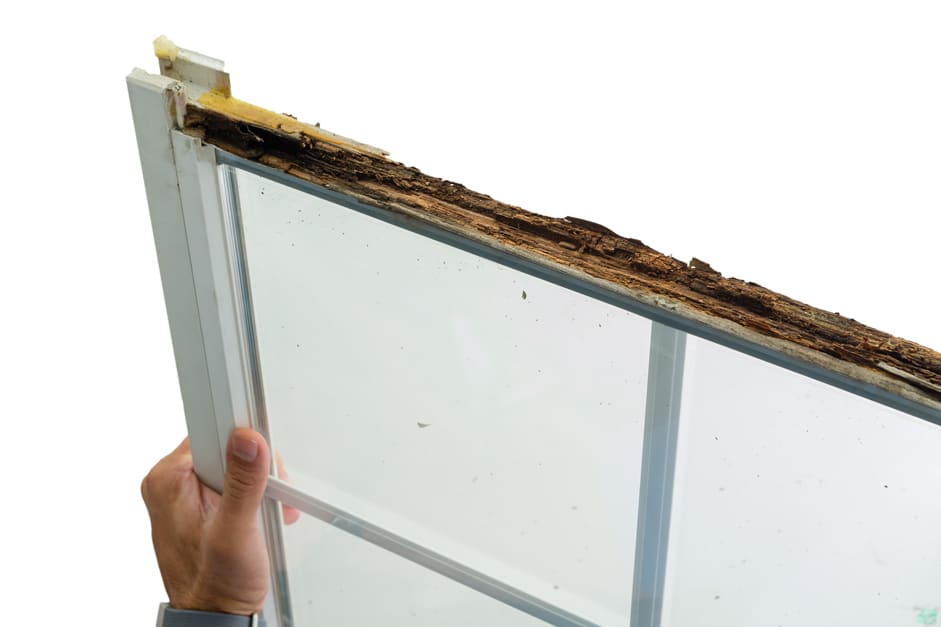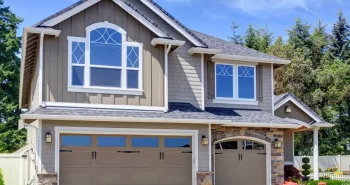Windows are integral to any home. They provide natural light, ventilation, and a connection to the outside world. However, issues like wood rot can impact your windows’ functionality, aesthetics, and efficiency. To help you better understand this occurrence, here’s everything you need to know about wood rot and its impact on your windows.
What Is Wood Rot?
Wood is held together by millions of tiny layers of cellulose—a type of insoluble fiber. The cellulose helps maintain each piece of wood’s shape and structural stability. However, when exposed to moisture, the cellulose will absorb and retain the water, which can lead to wood rot. Wood rot, also known as wood decay, is a natural process that occurs when wood is exposed to moisture and microorganisms that break down its fibers. It’s a type of fungal decay that can affect several different types of wood, leading to structural damage that can compromise the integrity of the wood itself.
Causes of Wood Rot
Simply put, wood rot is caused by moisture. However, several other conditions can increase the risk of wood rot occurring. Some of the most notable causes of wood rot include the following:
- Exposure to moisture
- High levels of rain or snow
- Growth of fungi
- Warm temperatures
- Humid conditions
- Lack of ventilation
- Poor window maintenance
- Lack of painting or sealing windows
- Improper window installation
Different Types of Wood Rot
Rot can occur on any structure that’s made from wood and can lead to a variety of different issues. However, to understand how to prevent and treat it, it’s important to understand the three different types of wood rot: brown rot, white rot, and soft rot.
1. Brown Rot
Brown rot is the most common type of wood rot. Even though the fungi grow slowly, they can rapidly degrade wooden structures. Brown rot occurs when a specific type of fungus permeates the wooden structure and starts to break down the cellulose inside. This can lead to cracks and splits, as the cellulose loss causes the wood to dry out. Therefore, brown rot is also commonly referred to as “dry rot,” despite the fact that moisture is still the underlying cause.
2. White Rot
White rot fungi target both cellulose and lignin in wood, resulting in white spots or a whitish/yellowish color appearance throughout. However, this type of wood rot results in a spongy or stringy texture rather than looking dried out. White rot fungi tend to grow rapidly, but decomposition may not be as fast as brown rot due to how the wood is affected. Still, white rot is considered the most aggressive type of wood rot and needs to be addressed as soon as possible.
3. Soft Rot
Soft rot is less common and tends to occur in areas with extremely high moisture levels. Often, this means wood is partially submerged in water or exposed to ongoing moisture. Although this wood rot advances slowly, it usually begins deeper in the wooden cavities and can be difficult to treat.
How Does Wood Rot Impact Windows?
Wood rot can have catastrophic effects on the structure in question. The sooner the wood rot is addressed, the better the likelihood of salvageable conditions. Regardless, wood rot can affect both the aesthetics and functionality of your windows and home. Some of the biggest ways wood rot impact windows include the following:
Structural Damage
One of the most notable ways that wood rot impacts windows is through structural damage. As the rot progresses, it weakens the structural integrity of the window frame and any surrounding wooden structures. Over time, this can lead to sagging or misaligned windows, which can cause problems with opening and/or closing the glass. When left unaddressed, the structural damage may get so bad that the window frame collapses. Although the wood rot should be visible and obvious before collapse occurs, regular inspections can help you catch warning signs or indications of mold before it spreads.
Energy Efficiency
Wood rot can also compromise the insulation properties of your windows. Over time, the rot can result in gaps and cracks throughout the wood. These areas allow drafts to enter your home, thus increasing the strain put on your HVAC system. This results in higher energy bills, as the heating or cooling system needs to work harder to maintain a comfortable indoor environment. When not addressed, these cracks and gaps can worsen, thus further decreasing the energy efficiency of your home.
Aesthetic Issues
Even if you don’t put too much effort into the aesthetic appeal of your home, wood rot can be an eyesore. Rotting wood is unsightly and usually pretty apparent. It can negatively impact the curb appeal of your home, which may result in violations with your homeowner’s association. Rot can result in peeling paint, discolored wood, cracks, and other signs of visible decay, which can make your home look neglected.
Respiratory Issues
Since wood rot occurs from the overgrowth of fungi, mold, and mildew will eventually appear. Over time, this leads to the release of spores in the air, which can reduce indoor air quality and cause severe health problems. Although individuals with respiratory conditions or allergies are at a higher risk of the negative effects of mold and wood rot, it can still cause respiratory symptoms in otherwise healthy individuals. If you or anyone in your family begins to experience respiratory symptoms and notice signs of potential wood rot, it’s important to seek medical attention and contact a home exterior contractor as soon as possible.
Preventing Wood Rot in Windows
Taking a proactive approach is recommended if you want to avoid dealing with the problems associated with rot. Luckily, there are a few things you can do to help prevent rotting wood around your windows. This can lead to better longevity and improved functionality over time. To help, consider the following preventative measures you can take to avoid wood rot.
Schedule Regular Inspections
Undergoing regular window inspections is a great way to help prevent wood rot or at least catch it before it spreads. A professional contractor who specializes in windows will understand what to look for. This includes signs of decay such as discoloration, soft spots, peeling paint, or other less noticeable damages. Early detection is the best way to prevent further damage and take control of the situation before it spreads.
Maintain Paint and Finish
Another preventative measure you can take is to make sure that your windows have well-maintained paint and finish. Both paint and finish can act as a protective barrier against moisture, thus decreasing your risk of wood rot. If you notice your paint starts to peel or crack, schedule an inspection and repaint as necessary.
Ensure Proper Ventilation
Another preventative measure against window rot is proper ventilation. When your home is well-ventilated, it’s less likely that moisture will get trapped and start to build up. This includes everything from attic ventilation to exhaust fans in the bathroom and kitchen. You should also try to open your windows occasionally to allow air to flow through your home.
Manage Moisture
If you notice moisture around your windows, try to address them as soon as possible. This could include leaky gutters or downspouts, inefficient window paneling, or areas where rain accumulates nearby. When you manage external sources of moisture, you reduce the risk of the water penetrating the wood.
Schedule Repairs as Needed
Unfortunately, windows don’t last forever. However, regular maintenance and timely repairs can help you boost their longevity and address any issues before they worsen. This can decrease the chances of both wood rot and premature window replacement. Call a professional for an inspection and repair if you notice any problems, regardless of how big or small.
Repairing Wood Rot in Windows
Even with preventative measures, wood may rot over the years. If you notice any signs of wood rot in your windows, it’s important to address it properly to avoid costly repairs or complete window replacements. Contact a home exterior contractor for an assessment and any necessary window repair for the best result. They can remove the affected wood before the rot spreads, treat it with fungicide, and help minimize the spread of rot.
If you notice any signs of wood rot, contact the professional contractors at First Star Exteriors. Our team can help you identify, treat, and repair any signs of wood rot to keep your home functioning at its best. At First Star Exteriors, we pride ourselves on hands-on, personable partnerships with our clients, so we always work to ensure your needs are met. To learn more about our ventilation services, or to receive a free quote within 48 hours, contact us today.





